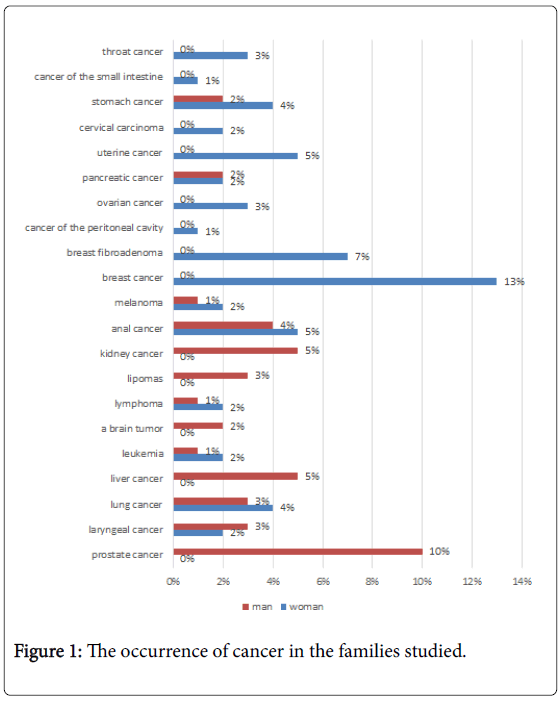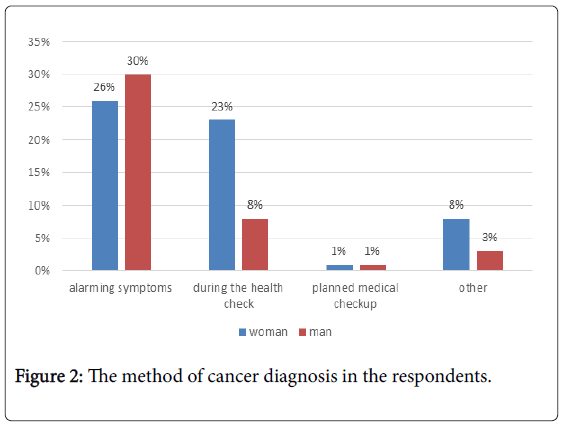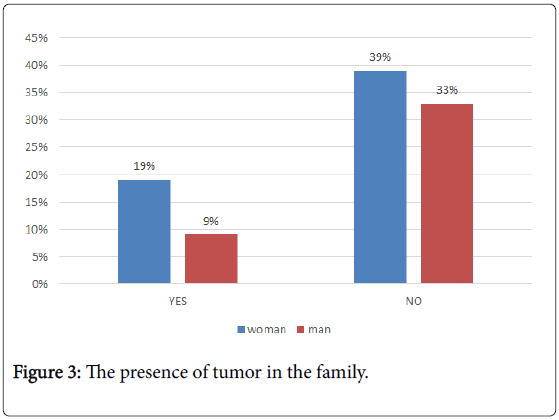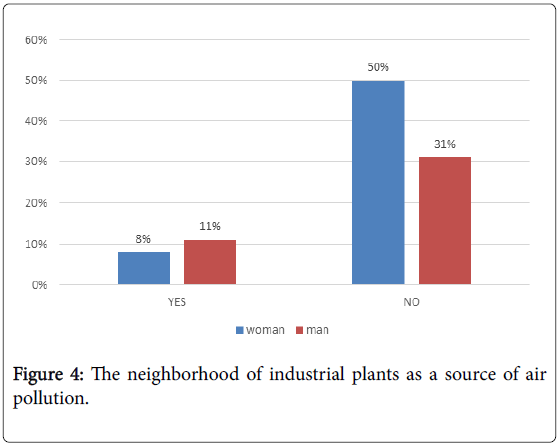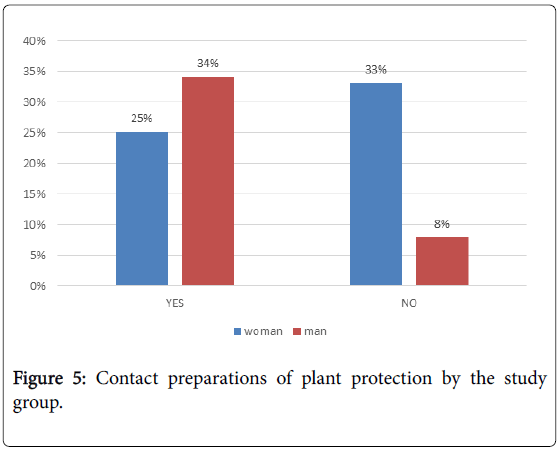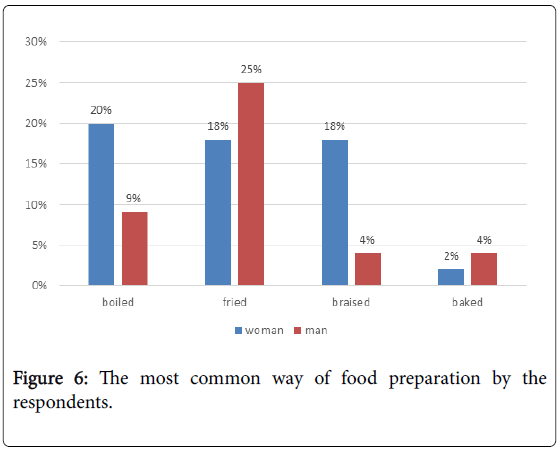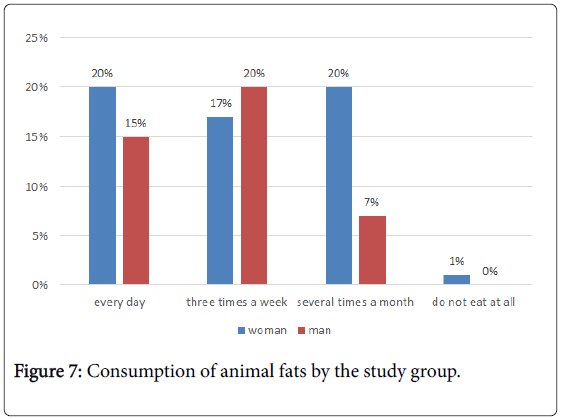The Analysis of Incidence of Risk Factors of Neoplastic Diseases among Patients with a Diagnosed Neoplastic Disease
Received: 07-Feb-2017 / Accepted Date: 16-Feb-2017 / Published Date: 23-Feb-2017 DOI: 10.4172/2161-1165.1000294
Abstract
Introduction: Risk of neoplastic diseases in the whole world’s population has been increasing regularly. Thanks to the GLOBACAN data base operating under the auspices of the International Union Against Cancer it has been reported that up to 2002 10,900,000 of new cases of cancer were diagnosed and 6,700 deaths were reported. According to the World Health Organization, in 2020 we may expect about 10 million deaths, including 7-8 millions in the developing countries, while this number in the developed countries will not change and will be 2-3 million. The world’s most frequently occurring tumour is lung cancer. It accounts for 12.4% of all tumours diagnosed. According to the epidemiological research, the basic factors responsible for cancer development among people are those environmental factors that result from humans’ behaviour.
Objective: The objective is to analyze the occurrence of risk factors of a neoplastic disease among patients with a diagnosed oncological disease.
Material and methods: The research involved 500 patients of the oncology department. Women accounted for more than a half of all patients, namely 58%, while men 42%. In order to obtain the research material, a standardized questionnaire has been applied, including interview and physical examination, enabling assessment and analysis of occurrence of cancer risk factors.
Results: The most frequently diagnosed tumour among women is breast cancer (20%), while among men the most frequently occurring is prostate cancer (10%). 20% of women and 10% of men lived near high-voltage line. 11% of women were active smokers while 6% passive smokers. When it comes to men, 18% were active smokers, while 5% passive smokers.
Conclusions: The most frequent cancer among women is breast cancer, while among men prostate cancer. Smoking does not have a significant influence on cancer development in women; however, it has a significant influence on cancer development in men. Overweight and obesity have a significant influence on cancer development in women, while they have insignificant influence on cancer development in men.
Keywords: Risk factors; Neoplastic disease
165733Introduction
Risk of neoplastic diseases in the whole world’s population has been increasing regularly. Thanks to the GLOBACAN data base operating under the auspices of the International Union Against Cancer it has been reported that up to 2002 10,900,000 of new cases of cancer have been diagnosed and 6,700 deaths reported.
Occurrence of oncological illnesses was estimated to concern 24,600 people. The highest incidence of cancer (44.9%) has been reported in Asia. In China, 20.3% of the total number of neoplastic diseases is diagnosed. The second place with the percentage of 26% belongs to Europe and the third to the North America with 14.4%. The next are Latin America and the Caribbean (7.7%), Africa (6%), and Oceania (1%). In North America there’s the highest incidence both in men and women [1]. According to the World Health Organization, in 2020 we may expect about 10 million deaths, including 7-8 million in the developing countries, while this number in the developed countries will not change and will be 2-3 million [2].
The world’s most frequently occurring tumour is lung cancer. It accounts for 12.4% of all tumours diagnosed and in 2002, 1,305,000 of cases of this disease have been reported. Lung cancer is the cause of 17.5% of deaths caused by neoplastic diseases. In the last 17 years, the number of patients suffering from lung cancer has increased by about 51%. In regions such as Europe and the United States the rate of lung cancer related to smoking reaches up to 90-95% in men. Breast cancer is the second on world’s cancer list. In 2002 1,150,000 new cases of this cancer have been diagnosed and it is the most common when it comes to incidence of cancer in women with a rate of 23%. In Europe and North America more than a half of cases of this cancer in women occur. Breast cancer is a cancer of a rather better prognosis. It is the fifth on the list in terms of number of deaths caused; however, it is still high on the list and is responsible for 414 thousand of deaths (14%). The third most frequent cancer in the world is a colorectal cancer with incidence rate at about 1 million per year. It accounts for about 9.4% of all cancers and is the fourth when it comes to cancer incidence among men, and third among women. It is the cause of 529 thousand of deaths a year. Colorectal cancer occurs most frequently in North America, Australia and Western Europe; the least frequently in Africa and Asia. The fourth frequent cancer in the world is stomach cancer with incidence rate at about 934 thousand per year that accounts for 8.6% of all cases of cancer. Stomach cancer is the second most frequent cause of death caused by cancer that accounts for 700 thousand deaths a year. The highest incidence rate has been reported in the Eastern Asia, Eastern Europe, and South America, while the lowest in North Africa and North America. In the developing countries, 75% of cases of this cancer were reported, and about a half of it was reported in China. The fifth position in the world in terms of cancer incidence belongs to prostate cancer with 679 thousand of cases of the disease and 221 thousand deaths a year. The highest incidence rate has been reported in the USA (124.8/100 thousand) thanks to early detection of the cancer in the asymptomatic period of the disease and mass screening tests. The next regions with high incidence rate are Western Europe, while those with low incidence are South and Central Asia, and China.
What distinguishes this cancer from other types is its diverse incidence rate depending on the ethnic population. It has been proved by the data on incidence rate difference among America’s black inhabitants that turned out to be by about 70% higher than in white race, and white race’s results were higher than of Asian people [1].
Cancer is the second frequent cause of death in Poland. For the last 40 years, due to tumours, incidence and mortality rate in Poland has been increasing. When it comes to incidence rate in Poland, the most frequent in men is lung cancer and in women breast cancer. The incidence rate of breast cancer cases has been regularly increasing and it is estimated that in 2015 it will be more than 17,000. For a few years now, the second most frequent cancer has been colorectal cancer, both in women and men, and it has been observed that the incidence rate of this cancer type has been regularly increasing (about 2.5% annually). In 2007 in Poland, 128,883 new cases of the cancer have been reported, including 64,288 in men and 64,595 in women. The most frequently reported in men are: lung cancer (14,659 cases), colorectal cancer (7,996), prostate cancer (7,638), and then bladder cancer, skin cancer, and stomach cancer. In women, the most frequently occurring are: breast cancer (14,482 cases), colorectal cancer (6,549), lung cancer (5,250), and then endometrial cancer, skin cancer, cervical cancer, and ovarian cancer [3].
Objective
The objective is to analyze the occurrence of risk factors of a neoplastic disease among patients with a diagnosed oncological disease.
Material and Methods
The research involved 500 patients of the oncology department. Women accounted for more than a half of all patients, namely 58%, while men 42%. The vast majority of women (30%) are city residents, the remaining part, i.e. 28%, are residing in a village. When it comes to male respondents, 24% declare that they live in a city, while 18% in a village. The women aged under 20 account for 2%, those between 20 and 30 (7%), 30-40 (9%), 40-50 (19%), 50-60 (15%), and over 60 (15%). In the male group, men under 20 account for 1%, those between 20-30 and 30-40 (3%), 50-60 (14%), 40-50 (11%), and over 60 (10%). The majority of the surveyed women (47%) are married, while 11% are single. 37% of the male respondents are married, while 5% are single.
In order to obtain the research material, a standardized questionnaire has been applied including interview and physical examination, enabling assessment and analysis of occurrence of cancer risk factors and physical examination assessing the prevalence of overweight and obesity. All the statistical calculations have been performed by use of data analysis software system STATISTICA developed by StatSoft, Inc. (2011), version 10.0. (www.statsoft.com) statistical package R version 2.15.1 and Microsoft Excel spreadsheet. Quantitive variables have been characterized by arithmetic mean, standard deviation, median, minimum and maximum value (range), and 95% CI (confidence interval). Qualitative variables have been presented by use of cardinality and percentage value. In statistical analysis the following tests have been applied: Shapiro-Wilk, Levene, Brown-Forsythe, Student’s t-distribution, Mann-Whitney U, ANOVE F-test, and Kruskal-Wallis.
Results
Socio-demographic characteristics of respondents
According to the research, 26% of the female respondents have secondary education, 15% vocational education, 13% higher education, 4% primary education. Among men, 16% have secondary education, 15% higher education, and 11% vocational education.
According to the research, 9% of men are unemployed, 6% work as builders, and 3% are locksmiths, 3% drivers, while 5% are retired. The least frequent profession is a farmer (2%), warehouse attendant (2%), teacher (2%), policeman (1%), student (1%), economist (1%), maintenance technician (1%), electrician (1%), bodyguard (1%), salesman (1%), physician (1%), and mechanic (1%). Among female respondents, 8% are retired, 8% are saleswomen, 8% are housewives, 6% are teachers, 4% are cleaning ladies, and 5% are unemployed, while 4% are pensioners. The least frequent professions are a nurse (3%), cook (2%), accountant (2%), student (2%), masseuse (1%), medical health officer (1%), librarian (1%), waitress (1%), farmer (1%), and postal worker (1%).
According to the data collected, 27% of the female respondents describe their financial situation as rather good, 19% as average, 11% as good, 1% as poor. In the male group, 18% describe their financial situation as average, 15% as good, 6% as rather poor, and 3% as rather good.
In the group of women, the most frequent are breast cancer (20%), anal cancer (5%), endometrial cancer (5%), lung cancer (4%), and stomach cancer (4%). The least frequent are laryngeal cancer (2%), leukaemia (2%), lymphoma (2%), melanoma (2%), pancreatic cancer (2%), cervical cancer (2%), peritoneal cavity cancer (1%), and small intestine cancer (1%). In the male population, the most frequent are prostate cancer (10%), liver cancer (5%), kidney cancer (5%), anal cancer (4%), laryngeal cancer (3%), and lung cancer (3%). The least frequent are brain cancer (2%), pancreatic cancer (2%), stomach cancer (2%), leukaemia (1%), lymphoma (1%), and melanoma (1%) (Figure 1).
Analysis of circumstances related to diagnosis of a neoplastic disease shows that only 30% of male patients and 26% of female patients have suffered from disturbing symptoms. In the group of women the symptoms were as follows: blood in stool (2%), hoarseness and sore throat (1%), vaginal bleeding (1%), stomach ache (1%), and weakness (20%). In the group of male respondents, 1% suffered from hoarseness and sore throat, cough (21%), and weakness (15%). During check-ups tumours have been detected in 8% of men and 23% of women (Figure 2).
In the group of 39% of women there was no case of a neoplastic disease in family, while in 19% of women, the disease has occurred in family. In the group of 33% of men there was no case of a neoplastic disease in family, while in 9% the disease has occurred (Figure 3).
The majority of the surveyed women learn about a neoplastic disease from the qualified experts (39%), 8% use other sources, 3% use Internet, 2% from family. The next 2% learn from TV and magazines, then 2% from specialised literature, and the last 2% from a family physician. 27% of men acquire knowledge from qualified experts, 5% go to the specialised literature, the next 5% use Internet. 3% of men acquire knowledge from a family physician, and the last 2% from other sources.
When it comes to exposure of the respondents to physical factors, 38% of women and 32% of men have not lived near high-voltage line, while 20% of women and 10% of men claim that they stayed near highvoltage line. When it comes to the time spent near the high-voltage line, 10% of women lived near it for 35 years, 5% for 10 years, 3% for 15 years, 2% for 25 years. In the male population, 3% lived near it for 35 years, 3% for 10 years, and the least, 1%, for 25 years.
According to the answers collected, only 9% of women used hormonal contraception.
More than a half of women (56%) and 42% of men have never used solarium. As many as 35% of men and 33% of women remained in the sun without any protection between 10 AM and 3 PM. During their time spent in the sun, 40% of female respondents and 30% of men did not apply any protective filters. According to the answers collected, 5% of women and 14% of men have experienced sunburn.
Assessment of smoking frequency in the surveyed group has shown that 11% of women smoke actively, 6% smoke passively, 5% used to smoke in their youth. 18% of the male respondents smoke actively, 8% used to smoke in their youth, while 5% smoke passively. According to the data, 14% of male respondents smoked for at least 20 years, 8% smoked for 10 years, and 4% smoked for 5 years. When it comes to women, 10% smoked for at least 20 years, 3% for one year, 2% for 5 years, and 1% for 10 years. When it comes to a number of cigarettes smoked, in the group of men 8% smoked between 10-20 cigarettes a day, 8% smoked up to 9 cigarettes a day, 6% smoked more than 30 cigarettes a day, and 4% smoked between 20-30 cigarettes a day. In the group of women, 6% smoked up to 9 cigarettes a day, 4% smoked more than 30 cigarettes a day, 4% smoked between 10-20 cigarettes a day, and the least, 2%, smoked between 20-30 cigarettes a day.
According to the data, 38% of men drank alcohol, while in the group of women the percentage rate was 28%. 19% most frequently drink 0.5 of a shot glass, 5% 2 shot glasses and more, 4% one shot glass. In the group of men, 18% most frequently drink 0.5 of a shot glass, 8% 2 shot glasses and more, and, the least, 6% drink one shot glass.
According to the answers collected, in the group of women, 37% perform physical activity 5 days a week for 30 minutes, 18% 7 days a week for 30 minutes, the least, 3%, 5 days a week for an hour. In the group of men, 25% perform physical activity 5 days a week for 30 minutes, 12% 7 days a week for 30 minutes, the least, 5%, spend an hour 5 days a week on physical activity.
Only 8% of women and 11% of men live in the vicinity of industrial plants (Figure 4).
Ammonia hair dye was used by 18% of women every three months, by 8% every six months, and the least, 5%, 3 times a year. Joss sticks were used only by women (4%). 37% of men and 25% of women were exposed to plant protection chemicals (Figure 5).
When it comes to occurrence of overweight and obesity among respondents, 44% of women were overweight or obese, while when it comes to men 16%. According to the analysis of nutrition mistakes, 20% of women consumed animal fat every day, 20% a few times a month, 17% three times a week, and the least, 1%, did not consume it at all. In the group of men, 20% consumed animal fat and oils three times a week, 15% every day. As many as 25% of men and 18% of women ate fried meals, and 24% of men and 16% of women ate meals with a large amount of salt (Figures 6 and 7).
When it comes to a question regarding frequency of radiography and CT, 33% of women said they performed the tests every 5 years, 19% once a year, while 6% more frequently than every six months. 26% of men perform radiography or CT once in five years, 13% once a year, and the least 3% more frequently than every six months.
The last part of the research was aimed at assessment of screening tests in the group of respondents. In the group of women, 33% have never had screening tests performed, while in the group of men the percentage rate was 25%. 12% of women had tests for hepatitis B and C, 8% had tests for helicobacter pylori, 2% for HPV, 25% breast ultrasound, 23% abdomen ultrasound, 12% tumour marker test, 8% colonoscopy, 7% dermatological skin examination, 3% stool test for blood, the least, 1% catecholamine levels. In the group of men, 8% had tests for hepatitis B and C, while 3% had tests for helicobacter pylori, 11% abdomen ultrasound, 10% tumour marker test, 4% colonoscopy, 3% stool test for blood and 3% dermatological skin examination.
Discussion
Epidemiological research on cancer development since many years have been aimed at establishing and influence of environmental and genetic factors on cancer incidence and mortality rate. According to the current knowledge, the cause of 80-90% of cancers are external environmental factors (carcinogens). According to the epidemiological research, the basic factors responsible for cancer development among people are those environmental factors that result from human’s behaviour. The research has proved that smoking, excessive alcohol consumption, diet, reproductive behaviour are of great importance when it comes to malignant tumours development in human population [4].
One of the most frequently mentioned carcinogens is ionizing radiation that may induce cancer in every organ, where cancer appears spontaneously [5,6]. The first reports on the danger of ionizing radiation emerged in the mid-twentieth century after the observations of children who survived the atomic bomb explosions in Hiroshima and Nagasaki, as well as children who were exposed to radiography in the prenatal period. An increased risk of leukaemia and thyroid cancer has been established [7]. It has been also established that a diagnostic radiology test performed in a pregnant woman increases a risk of childhood cancers. The risk depends on the radiation dose and number of exposures. According to the literature reviewed, a percentage of all tumours attributable to radiation is 2-3%. In children exposed to X-rays, the most frequently observed are liver cancer, bone tumour, and leukaemia. Necessity of radiotherapy in case of already existing tumours in children significantly increases a risk of secondary tumours [5,6]. During usage of higher doses of radiation in brain tumours therapy, a risk of meningiomas and gliomas increases, whereas women who due to cancer in their childhood underwent chest radiation are now at increased risk of breast cancer. According to the research conducted by Bhatia et al., risk of breast cancer increases about 8 years after radiation, while cancer develops usually before the age of 40 [6]. Ionizing radiation may stimulate carcinogenesis also in case of penetrating radiation of thyroid gland (thyroid cancer), chest (lung cancer), and urinary bladder (bladder cancer). According to the literature reviewed, radiotherapy in childhood stimulates carcinogenesis in gastrointestinal tract and the risk of other gastrointestinal cancers is much higher than in general population [6].
Sunlight is the most frequent environmental factor affecting skin and its harmful properties result mainly from ultraviolet radiation [8]. Chronic and excessive exposure to sunlight frequently leads to adverse early effects such as erythema or sunburn as well as late effects such as accelerated skin aging and even carcinogenesis. It has been proved that excessive exposure to ultraviolet radiation significantly increases the risk of pigmented and non-pigmented skin tumours: malignant melanoma and squamous-cell carcinoma [9,10].
UVB radiation with a wave length from 280 nm to 315 accounts for 5% of UV radiation that reaches the Earth’s surface; the remaining percentage is UVA radiation [8]. The accumulation of DNA damages caused by UV rays has a mutagenic and complex effect: on one hand, it damages routes leading to apoptosis of the damaged cells; on the other hand it promotes proliferation of the changed and immature cells. As a result of UV radiation, by creation of pyrimidine dimmers, or thymine with cytosine and 6.4-photoproducts, DNA of epidermis cells gets damaged [11]. Direct mutagenic effect as well as local immunosuppression in the skin are caused by exposure to UVB that is about 1,000 more mutagenic than UVA, however, UVA has been proved to have a direct influence on DNA cells damage [10,12-15].
Sunbathing in solarium also has been proved to have a carcinogenic effect. UVA radiation doses emitted by solarium lamps are significantly higher than those to which skin is exposed to in the sun, which may cause anomalies in the immune system mechanisms. According to the research on influence of artificial UV radiation sources on skin cancer development, more frequent and longer use of solarium increases risk of malignant melanoma and squamous-cell carcinoma. Based on numerous researches, International Agency for Research on Cancer classified in 2009 radiation emitted by solarium lamps as a carcinogenic factor in skin cancer like other carcinogens such as arsenic compounds, coal tar, and soot [10,12-15]. More than a half of women (56%) and 42% of men have never used solarium. As many as 35% of men and 33% of women remained in the sun without any protection between 10 AM and 3 PM.
Smoking is a single and one of the most important causes of tumours. According to the research conducted by the American Cancer Society, smoking is causally related to at least 16 types of tumours. Smoking increases a risk of squamous-cell carcinoma of oral cavity, bronchial tumour, tumours of the throat, esophagus, pancreas, kidney, bladder, lung cancer, colorectal cancer, nasal cavity cancer and paranasal sinuses cancer, esophageal cancer, stomach cancer, pancreas cancer, liver cancer, bladder cancer, cervical cancer, as well as myeloid leukemia [16]. Smokers are exposed to 4,000 substances in cigarette smoke that are toxic and irritate respiratory epithelium, affect ciliary movement and block activity of respiratory enzymes. Almost 50 components of cigarette smoke are claimed to be carcinogenic, among which the strongest are: benzene, dimethylnitrosamine, ethyl methyl nitrosamine, diethylnitrosamine, nitrosopyrrolidine, hydrazine, and vinyl chloride. Also, numerous co-carcinogens have been discovered that are substances that do not have carcinogenic features, however, they strengthen the process of carcinogenesis even if the number of carcinogens is negligible. These are: formaldehyde, pyrene, fluoranthene, naphthalenes, and catechol [17]. In the research conducted in Great Britain a relative risk of cancer in children born by women who smoked while pregnant 5 and more cigarettes a day was 2.5 (95% CI 1.2-5.1). In the research conducted in Sweden, it has been reported that there’s statistically increased risk of a chronic lymphocytic leukaemia in children whose mothers smoked while pregnant. In meta-analysis conducted by Boffetta et al., relative risk of cancer in children whose mothers smoked while pregnant was 1.1 (95% CI 1.3-1.19), relative risk of lymphatic and hematopoietic tissue cancer was 1.03 (95% CI 0.9-1.2), of non-Hodgkin lymphoma and other lymphomas 1.1 (95% CI 0.9-1.5), central nervous system cancer 1.04 (95% CI 0.92-1.18), while of leukaemia 1.1 (95% CI 0.8-1.3) [18]. Assessment of smoking frequency in the surveyed group has shown that 11% of women smoke actively, 6% smoke passively, 5% used to smoke in their youth. 18% of the male respondents smoke actively, 8% used to smoke in their youth, while 5% smoke passively.
The epidemiological researches have proved that there is a causal relationship between alcohol consumption and higher risk of a neoplastic disease. Alcohol consumption increases a risk of cancer of oral cavity, throat, esophagus, liver, and breast [19,20]. The size of the risk is varied and depends on quantity of alcohol consumed, its type and influence of other factors. Even little quantities of alcohol may increase risk of a tumour. Some of the researches have proved that one alcoholic drink a day (6-8 g of pure ethanol) increases a risk of breast cancer by 11%, while 2 alcoholic drinks a day increase a risk of colorectal cancer by 8%. International Agency for Research on Cancer (IARC) has classified alcohol as a first class carcinogen for liver cancer [20]. Alcohol consumption, both high-proof and low-proof (10-12%), increases a risk of a neoplastic disease. Alcohol is favourable to development of changes by affecting “mucous membrane directly as it eliminates lipid components of a barrier that surrounds granules of a spinous layer of the epidermis, or indirectly by affecting liver detoxification”. The most recent research has shown that regular and long-term usage of a liquid mouthwash containing alcohol is a factor favourable to development of tumours in head and neck, irrespective of habitual smoking and alcohol consumption. Taking into account a cancer of oral cavity, throat and larynx only, usage of liquid mouthwash containing alcohol twice a day increases a risk of cancer over tenfold in smokers, over fivefold in people consuming alcohol and almost fivefold in people who do not consume alcohol [17]. In the research conducted in Sweden, in the group of 605 patients suffering from squamous-cell carcinoma in the area of head and neck, a risk of oral cavity cancer has been determined when consumption is higher than 50 gm/dl of pure alcohol and RR=5.7 (95% CI=2.8-11.9). Probability of throat cancer was estimated in the research at RR=8.5 (95% CI=4.0-18.1). According to some of the researchers, of the greatest importance in terms of risk factors is wine consumption. In the research conducted by Franceschi et al. It has been proved that beer consumption and high-proof alcoholic beverages do not increase a risk of oral cavity cancer, in contrast to the consumption of wine. With consumption of 35-55 glasses of wine a week (i.e. about 1 liter of wine a day) a risk of oral cavity cancer is OR=1.9 (95% CI=0.9-3.7). Identical values of risk have been collected when it comes to a throat cancer [19]. According to the data, 38% of men drank alcohol, while in the group of women the percentage rate was 28%.
International Agency for Research on Cancer (IARC) has classified formaldehyde as a substance with a proved carcinogenic effect on humans, based on research in humans and animals. IARC concluded that it has an influence on development of nasopharynx cancer, sinonasal carnicoma, and leukaemia in people exposed to it in industry. It has been proved in the compound’s mechanism that in reaction with purine bases, give alkyl derivatives that consequently may interfere in “DNA damages repair mechanisms or cause crosscoupling of RNA, single-stranded DNA and proteins” [21]. Ammonia hair dye was used by 18% of women every three months, by 8% every six months, and the least, 5%, 3 times a year. Joss sticks were used only by women (4%). 37% of men and 25% of women were exposed to plant protection chemicals.
Inadequate diet is considered to be one of the main causes of cancer. Due to civilization development, in the surrounding environment, also in food, there are numerous agents toxic for an organism that contain carcinogens [22-24]. Probably about 30% of all types of cancers depend on a diet, which means that nutritional factors have an influence on their development. Among these types of cancer are colorectal cancer, breast cancer, esophagus cancer, stomach and pancreas cancer. Nutritional factors that predispose cancer to occur are high energy diet and obesity resulting from it, high fat diet, insufficient dietary fiber consumption, low calcium and antioxidant vitamins intake as well as high sodium diet [25]. Poorly balanced diet leads to overweight and obesity, which, according to the results of population studies, is becoming a serious epidemiological threat in the developed countries. There is a correlation between overweight, body mass index and a higher risk of cancer, mainly when it comes to colorectal cancer. According to the epidemiological research, overweight and obesity, that are becoming a growing epidemic among children and teenagers, are related to an increased risk of tumours in different parts of the body [23,24,26]. Diet rich in red and processed meat is a factor that increases a risk of colorectal cancer. Probably, it results from usage of nitrites and nitrates as meat preservatives, accumulation of heterocyclic amines and cyclic polycyclic hydrocarbons during thermal treatment of meat, as well as big amount of haem that stimulates production of n-nitroso-compunds in gastrointestinal tract, which may lead to cancer development [26]. Among other risk factors are vitamins deficiencies, especially vitamin A and iron that are favourable to development of oral cavity cancer. In some of the countries in South America, customary drinking of yerba mate is a risk factor [18]. More and more data in carcinogenesis of colorectal cancer and other tumours diet-related concern an influence of insulin and insulin-like growth factor. Based on the research results concerning the American society, whose diet is mainly composed of carbohydrates, it has been found that there is a relationship between high glycemic index and an increased risk of cancer development [25,26]. Also, various food products have an influence on neoplastic diseases development. Among Japanese inhabitants who consume the greatest quantities of rice a higher risk of colorectal cancer has been reported; a similar relation has been proved in Australia in case of high consumption of potatoes, while in American population, intake of higher number of snacks containing refined sugar correlated positively with a risk of cancer [26]. Among diet factors that may have an oncogenic effect, those that are perceived to be significant are high doses of nitrites and nitrates, salted foods, smoked and cured as well as too greasy or hot food [22-24]. When it comes to occurrence of overweight and obesity among respondents, 44% of women were overweight or obese, while when it comes to men 16%.
Mutagenic and carcinogenic substances dependent on environmental factors are present in many foods. They may be natural or be a result of storage and processing of food. The majority of them is classified as genotoxins, i.e. active forms of mutagen, that covalently bind with DNA molecule and modify nitrogenous bases, which leads to the synthesis of a protein with a changed sequence. Mycotoxins are strongly toxic, carcinogenic compounds produced by moulds, mainly Penicillium, Asparagillus and Fusarium. At present, about 400 mycotoxins are known, of which probably alfatoxins, ochratoxins, fumonisins, and zearalenone are significant in induction of breast cancer, liver, oesophagus, and prostate cancer [27,28]. They belong to the most serious contaminations that appear mainly during storage of numerous food products, most frequently in maize and peanuts [29]. Nitrosoamines are chemical compounds of strong carcinogenic features present in many food products, mainly in cured meat and smoked fish, but also in beer, soya sauce, and other. Research on adverse effect of nitrosoamines has proved a relation to stomach cancer [29]. Polycyclic aromatic hydrocarbons are produced in incomplete combustion of organic matter and contain a condensed arrangement of aromatic rings. The most carcinogenic in this group are benzo[a]pyrene and benz[a]anthracene. These compounds are present in fresh vegetables, tea, smoked sausage, and ham, but also they are produced during baking, frying, and smoking [29]. A strong mutagenic effect shows roasted, instant and decaffeinated coffee, smoked fish and meat, as well as meat stocks. These substances are also present in alcoholic beverages such as brandy and whisky [29]. Heterocyclic aromatic amines are strong mutagens produced as a result of thermal treatment of food with high protein content. They are produced in temperature higher than 3000 C that is why they are also present on the surface of fish and meat roasted over an open fire. In other products with high protein content such as eggs, milk, cheeses, and legumes, presence of mutagens can be established after the thermal treatment that leads to a color change due to e.g. being burnt [29]. Acrylamide most probably belongs to human carcinogens and is produced during thermal treatment of food with high starch content such as crisps, chips, coffee and bread [29].
In tumours development, more and more attention is paid to infectious agents that play a significant role in the etiology of these diseases [5,30]. Epidemiological data suggest that Helicobacter pylori infections show to have a relation to stomach cancer, C. Pneumonia to lung cancer, while Chlamydia trachomatis is a factor that predispose a cervical cancer to develop [28,31]. Oncogenic effects have been documented in some of human viruses. In tumour cells Epstein-Barr virus (EBV) has been indetified that causes nasopharynx cancer and Burkitt lymphoma, while the most recent research indicate that EBV participates in etiopathogenesis of stomach cancer, Hodgkin's lymphoma, as well as palatine tonsil cancer and tongue cancer [17,28,32]. Moreover, it has been proved that human Herpesvirus type 8 (HHV8) is etiopathogenetically related to Kaposi’s sarcoma that develops in Acquired Immune Deficiency Syndrome (AIDS) [5,28,30]. The next etiological high risk factor is Human papillomavirus (HPV) that shows similarity to cells of skin stratified squamous epithelium and mucous membranes. HPV is said to be the main infectious cause of cervical cancer and in the recent years also base-of-tounge cancer and tonsils cancer [17,28]. Infections caused by viruses Hepatitis B, C, and D (HBV, HCV, HDV) increase a risk of carcinogenesis due to ease of development of chronic infections, which may determine disorders of cell cycle regulation, consequently leading to neoplastic transformation. Original liver cancer probably in 80% is related to HBV [28,33].
In 1979, on the basis of the epidemiological research, Wertheimer and Leeper proved an increased risk of leukaemia among American children who live in houses with higher than standard intensity of magnetic fields. Based on that, in 1998, a group of experts from the US National Institute of Environmental Health Science came to a conclusion that there is a limited evidence base with respect to exposure to magnetic field being carcinogenic. WHO in the International EMF Project publication on “Electromagnetic Field” regards magnetic field of value 50/60 Hz as a probable carcinogenic factor [34]. There are also data based on epidemiological research that indicate a relation between exposure to a low-frequency magnetic field (0-300 Hz) and a risk of breast cancer. Six-and-a-half times higher risk of breast cancer has been proved among technicians working in a telecommunications company in New York as well as among women living within 300 m from high-voltage line in Sweden, where relative risk associated with exposure to fields of magnetic induction above 0.1 μT was twice as much high [35]. When it comes to exposure of the respondents to physical factors, 38% of women and 32% of men have not lived near high-voltage line, while 20% of women and 10% of men claim that they stayed near high-voltage line.
Conclusion
1. The most frequent cancer in women is breast cancer, while in men prostate cancer.
2. Good economic situation both in women and in men does not decrease a risk of a tumour, while poor economic situation does not increase a risk of a tumour.
3. Smoking cigarettes by women does not have a significant influence on tumour development, while smoking cigarettes by men has a significant influence on tumour development.
4. Overweight and obesity has a significant influence on tumour development in women, while in men overweight and obesity has an insignificant influence on tumour development.
5. Living in the vicinity of industrial plants does not have an influence on tumour development both in men and women.
References
- Kowalczyk JR, Samardakiewicz M (1998) Child with a neoplastic disease. PZWL publishing.
- Oeffinger KC, Hudson MM (2004) Long-term complications following childhood and adolescent cancer: foundations for providing risk-based health care for survivors. CA Cancer J Clin 54: 208-236.
- Chybicka A (2009) Early diagnosis of cancer in children. Elsevier urban and partner.
- Postrzech K, Welz K, Kopyra J, Reich A (2010) Impact of Ultraviolet B Radiation on Stratum Corneum. Dermatol Rev 97: 185-190.
- Batycka-BaranA, Kuczborska I, Szepietowski J (2012) Vitamin D and malignant melanoma-review of the literature. ClinDermatol 14: 37-41.
- Stawczyk M, Lakis A, Ulatowska A, Szczerkowska-dobosz A (2011) Evaluation and comparison of the risk of sunbathing addiction among selected population of women. Dermatol Rev 98: 305-311.
- Wolnicka-Glubisz A, Plonka PM (2007) The role of UV radiation in etiopathogenesis of melanoma. Contemporary Oncology 11: 419-429.
- Bien S (2005) Malignant Melanoma of Head and Neck. Otorynolaryngol 4: 113-120.
- Jen M, Murphy M, Grant–Kels J (2009) Childhood melanoma.ClinDermatol 27: 529–536.
- Kujawska–debiec K, Broniarczyk–dyla G (2008) Selected skin diseases caused by sunlight exposure. AdvDermatolAllergol 22: 61-65.
- Lesiak A (2009) Epidermal proliferation and intracellular adhesion impairment as one mode of action of ultraviolet-B radiation. AdvDermatolAllergol 26: 180–185.
- Vance RB (2004) Common interests and common goals: achieving greater progress in preventive health through strategic collaborations. OnkologiapoDyplomie 1: 5-6.
- Podlodowska J, Szumilo J, Podlodowski W, Staroslawska E, Burdan F (2012) Epidemiology and risk factors of the oral carcinoma. Pol MerkLek 32: 135-137.
- Polanska K, Hanke W (2005) Smoking cigarettes by women in the pregnancy and the state of the children health-the review epidemiologic studies.Epidemiol Rev 59: 117-123.
- Godlewski D, Wojtys P, Bury P (2000) Alcohol as a cancer risk factor. Contemporary Oncology 1: 13–15.
- Jarosz M (2008) Cancer:how to reduce a risk of the disease. Warsaw: PZWL publishing.
- Kupczewska-dobecka M (2007) Assessment of carcinogenicity of formaldehyde based on the newest literature data. Int JOccu Med Environ Health 58: 1-13.
- Chen YC, Hunter DJ (2005) Molecular epidemiology of cancer. OnkologiapoDyplomie, 2: 36-45.
- Chybicka A (2004) Influence of mother’s diet during pregnancy on cancer incidence in children. Prevention activities. J Med Sci6: 1213-1215.
- Eyre H (2004) Preventing cancer, cardiovascular disease, and diabetes: a common agenda for the american cancer society, the american diabetes association, and the american heart association. OnkologiapoDyplomie1: 7-24.
- Ciok J, Dolna A (2005)Glycaemic Index and neoplastic diseases. Contemporary Oncology9: 183-188.
- Gil J, Stembalska A,Laczmanska I, Sasiadek M (2010) Sporadic colorectal cancer-factors modulating individual susceptibility to cancer. Contemporary Oncology14: 211-216.
- Popadiuk S (2004) Malignant germ cell tumours. Multicenter prospective trial in Polish Pediatric Group for Solid Tumours (years 1998-2000). PrzegladLekarski 61: 29-32.
- Szkaradkiewicz A (2003) Microbes and oncogenesis. Contemporary Oncology7: 96-101.
- Lewandowska A (2013) The participation of nurses in the prevention and early detection of cancer in adolescents. Jaroslaw: PWSTE publishing.
- Gonza´lez CA, Agudo A (2012) Carcinogenesis, prevention and early detection of gastric cancer: where we are and where we should go. Int J Cancer 130: 745-753
- Dias EP, Rocha ML, Carvalho MOO, Fonte de Amorim LM (2009) Detection of Epstein–Barr virus in recurrent tonsillitis. Braz J Otorhinolaryngol, 75: 30-34.
- Malkowski P (2006) Hepatocellular carcinoma-epidemiology and treatment. Epidemiol Rev 60: 731-740.
- Szmigielski S (2009) Risk of neoplastic diseases in conditions of exposure to power magnetic fields-epidemiological investigations. Int J Occu Med Env Health 60: 223-233.
- Peplonska B, Szeszenia–Dabrowska N (2001) Occupational risk factors for breast cancer in the epidemiological studies. Int JOccu Med Env Health 52: 483-495.
Citation: Lewandowska A (2017) The Analysis of Incidence of Risk Factors of Neoplastic Diseases among Patients with a Diagnosed Neoplastic Disease. Epidemiology (Sunnyvale) 1:294. DOI: 10.4172/2161-1165.1000294
Copyright: © 2017 Lewandowska A. This is an open-access article distributed under the terms of the Creative Commons Attribution License, which permits unrestricted use, distribution, and reproduction in any medium, provided the original author and source are credited.
Select your language of interest to view the total content in your interested language
Share This Article
Recommended Journals
Open Access Journals
Article Tools
Article Usage
- Total views: 4307
- [From(publication date): 0-2017 - Aug 30, 2025]
- Breakdown by view type
- HTML page views: 3444
- PDF downloads: 863

